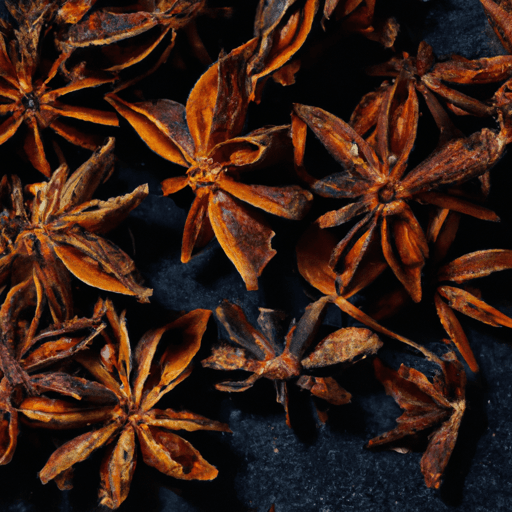The Allure of Whole Star Anise: Aromatic Spice with a Flair
If you are a food enthusiast seeking to add a touch of exoticism to your culinary repertoire, look no further than the fascinating whole star anise. Shaped like a delicate star, this aromatic spice not only adds a burst of flavor to your dishes but also offers a rich history and an array of health benefits. In this blog post, we will explore the diverse facets of whole star anise, including its taste profile, common uses in cooking, nutritional value, and captivating background.
Unraveling the Flavor Profile
Whole star anise enchants the senses with its enchanting aroma and distinct taste. Known for its licorice-like flavor, it adds a sweet and warm element to dishes, elevating them to new levels of culinary delight. When used in moderation, its flavor profile can be bold and invigorating, but be cautious not to overpower your dishes as it can become overwhelming.
Versatile Uses in Cooking
Whole star anise is a versatile spice that finds its way into a myriad of culinary creations. It shines best in slow-cooked dishes, infusing soups, broths, and stews with its captivating essence. It pairs wonderfully with meats, such as pork, beef, and poultry, adding a depth of flavor that leaves taste buds dancing. A touch of whole star anise can also transform simple desserts like poached fruits or custards, providing a subtle, aromatic twist.
Nutritional Value and Health Benefits
Beyond its sensory allure, whole star anise offers a range of nutritional benefits. It contains essential vitamins, minerals, and antioxidants that can contribute to a well-balanced diet. This spice is a rich source of vitamin C, which helps strengthen the immune system and promotes overall well-being. Whole star anise is also known for its anti-inflammatory and antimicrobial properties, making it a potential ally for maintaining good health.
A Glimpse into the History and Interesting Facts
Whole star anise carries a fascinating history that dates back centuries. Native to China and Vietnam, it has been an integral part of Chinese medicine and culinary traditions for over 3,000 years. It was valued not only for its distinctive flavor but also for its medicinal properties, believed to aid digestion and alleviate respiratory issues. Additionally, its star shape was considered a symbol of good luck and used as a decoration during festive occasions.
Cautionary Notes and Storage Tips
While whole star anise brings a delightful touch to dishes, it is important to note that its powerful flavor should be used sparingly. Its unique taste can dominate a dish if overused, resulting in an unbalanced flavor profile. It is recommended to use just one or two stars for most recipes, adjusting according to personal preference.
In terms of storage, whole star anise is best housed in an airtight container, away from direct sunlight, heat, and moisture. When stored properly, it can maintain its flavor and potency for up to a year, allowing you to enjoy its charms in the kitchen for many seasons to come.
Let Whole Star Anise Transport Your Taste Buds
Whole star anise is a mesmerizing spice that tantalizes with its captivating aroma and distinctive taste. From hearty stews to delicate desserts, it effortlessly elevates your culinary creations, leaving a lasting impression on your palate. With its rich history, nutritional benefits, and versatile uses, whole star anise is a must-have ingredient for any adventurous home cook. So embark on a culinary journey and embrace the alluring magic of whole star anise in your cooking today!
Whole Star Anise
Origin: Whole star anise, scientifically known as Illicium verum, is native to southern China and Vietnam. It has been cultivated in these regions for centuries and is commonly used in Asian cuisines.
Common Uses: Whole star anise is widely used as a spice in both sweet and savory dishes. It provides a distinct flavor to recipes with its licorice-like aroma and taste. It is commonly used in Chinese, Indian, Vietnamese, and Thai cuisines. It is an essential ingredient in Chinese Five-Spice Powder and is often used to flavor broths, soups, sauces, and marinades. It is also used in various desserts and baked goods, such as cookies and pastries.
Nutritional Benefits: Whole star anise contains several beneficial compounds, including antioxidants. It is also a good source of minerals like iron, calcium, and manganese. Additionally, it contains essential oils like anethole, which possesses antimicrobial properties. However, it is important to note that whole star anise is typically used in small quantities in cooking, so its nutritional benefits may be limited in terms of quantity consumed.
Unique Properties and Historical Significance: Whole star anise gets its name from its star-shaped appearance, with each of the star’s points containing a small seed. This spice has a strong and distinct flavor, which can be overpowering if used in excess. Historically, star anise has been used for its medicinal properties, particularly for its ability to aid digestion and treat various respiratory ailments. It was widely used in ancient Chinese medicine for its potential anti-inflammatory, analgesic, and antiviral properties.
Please note that while whole star anise complements many dishes, it is important to use it in moderation, as its strong flavor can dominate a recipe if used excessively.




Use the share button below if you liked it.
It makes me smile, when I see it.